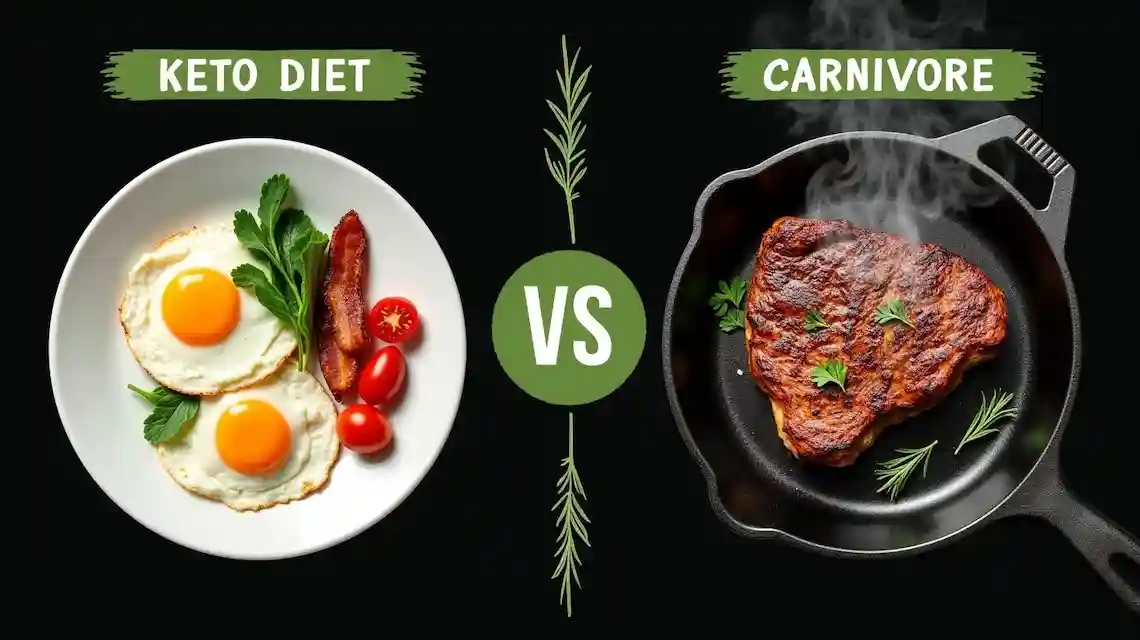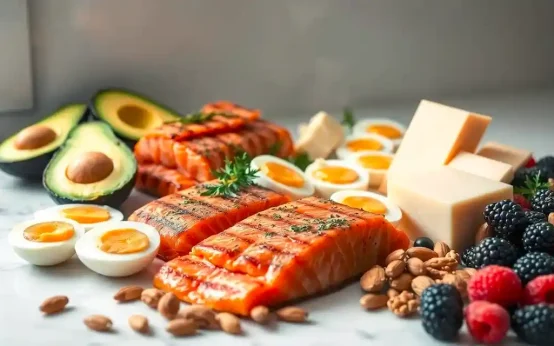Struggling with stubborn weight or daily energy crashes? You’re not alone. Many people look at the keto vs carnivore diet to cut carbs, burn fat, and feel steady energy without constant snacking.
Here’s the quick breakdown. Keto is high fat, very low carb, and includes meat, eggs, dairy, low carb veggies, nuts, and some berries. Carnivore is stricter, built around animal foods only, like beef, fish, eggs, and sometimes dairy.
Comparing these two matters if you’re new to low carb and want a plan you can stick with. Keto offers more food variety and fiber, which can help long term. Carnivore is simpler to follow, has fewer decisions, and some people find it reduces cravings fast.
In this guide, you’ll learn the key differences in macros, food lists, and flexibility. We’ll cover benefits like fat loss, appetite control, and mental clarity, plus common drawbacks, such as plateaus, digestion shifts, and social limits. You’ll also see who might thrive on each approach, from busy beginners to people with carb-sensitive blood sugar.
By the end, you’ll know which one fits your goals, tastes, and lifestyle. If you want more freedom and veggies, keto may suit you. If you want a short, strict reset, carnivore could help you start strong. Let’s keep it simple, practical, and set you up for success.
What is the Keto Diet and How Does It Work?
Keto is a high-fat, moderate-protein, very low-carb way of eating. The goal is ketosis, a metabolic state where your body uses fat for fuel instead of sugar. When carbs drop to roughly 20 to 50 grams per day, insulin stays low, stored fat releases, and the liver makes ketones for energy.
Core principles are simple. Eat plenty of healthy fats, like avocados, olive oil, butter, and nuts. Choose quality protein, such as meat, fish, eggs, and Greek yogurt. Fill your plate with low-carb vegetables, like spinach, broccoli, zucchini, and cauliflower. Unlike carnivore, keto allows plant foods, which adds fiber, micronutrients, and menu variety.
Many start with keto to drop weight fast and to control hunger. It is a common entry point if you want structure but still like some veggies and berries.
Here is a simple sample day to picture it:
- Breakfast: Eggs cooked in butter with spinach, side of avocado
- Lunch: Grilled chicken salad with olive oil and feta
- Snack: Handful of macadamias or full-fat cottage cheese
- Dinner: Salmon with asparagus and cauliflower mash
- Treat: A few raspberries with whipped cream
Key Benefits and Potential Drawbacks of Keto
Keto can support rapid fat loss. Lower carbs reduce water weight first, then fat stores burn as ketones rise. Many people notice steady energy and fewer afternoon crashes. With fewer blood sugar swings, those with type 2 diabetes or insulin resistance often see better glucose control. Ketones also provide a clean fuel for the brain, which can lead to mental clarity and improved focus. Lower appetite is common because higher fat and protein increase satiety, and stable insulin reduces hunger signals.
There are trade-offs. Early keto flu symptoms can include headaches, fatigue, and brain fog. This usually fades in a few days. Low-carb eating can cause electrolyte losses, so add sodium, potassium, and magnesium through broth, mineral water, and supplements. Cutting many plant foods may create nutrient gaps if meals are not planned well. Social events, dining out, and travel can be tricky at first. If you weigh the keto vs carnivore diet, keto offers more flexibility and fiber, which helps long-term consistency.
Understanding the Carnivore Diet: All Meat, No Plants
Carnivore is an extreme all‑animal‑product approach. You eat meat, fish, eggs, and sometimes dairy, while excluding plants entirely. There are zero carbs from food, no fiber, and no grains, fruits, or vegetables. For many, the appeal is its simplicity and strong satiety. You cook meat, season with salt, and eat until full. No tracking apps. No macros to juggle.
Fans point to ancestral eating patterns as inspiration. The idea is to remove modern triggers, such as seed oils, sugar, and plant compounds that may irritate sensitive guts. Carnivore often lands people in ketosis because carbs are near zero. It goes further than keto by removing plant foods altogether, which strips out variety and fiber. That trade can help those with stubborn bloating or autoimmune flares, but it requires careful planning.
What you can eat:
- Allowed: fatty cuts of beef, steak, ground beef, lamb, pork, bacon, chicken thighs, turkey, fish, shellfish, eggs, butter, ghee, salt, water, coffee or tea if tolerated.
- Sometimes: hard cheeses and heavy cream if dairy sits well.
- Avoid: all vegetables, fruit, grains, legumes, nuts, seeds, plant oils, and sweeteners.
Compared with keto, carnivore is stricter and less flexible. Keto includes non‑starchy vegetables for fiber and micronutrients, which can support long‑term adherence. Carnivore trades that variety for fewer decisions and strong appetite control. If you deal with gut sensitivities, skin woes, or joint pain, you may find short runs of carnivore reveal trigger foods. In the keto vs carnivore diet debate, carnivore serves as an elimination reset, while keto functions as a broader lifestyle you can maintain.
If you try it, prioritize nutrient‑dense cuts, organ meats if you eat them, and adequate electrolytes. Keep meals simple, such as ribeye with eggs or salmon and butter. Listen to your body and track how you feel.
Pros and Cons of Going Full Carnivore
Carnivore wins on simplicity. You skip carb counting and food labels. High protein and fat boost fullness, which can tame cravings and cut snacking. Some report calmer digestion, clearer skin, or less joint stiffness after removing plants, seed oils, and sugar. The plan often improves blood sugar stability because carbs are near zero.
There are real drawbacks. No plant foods means a risk of vitamin C shortfalls, which raises concerns about scurvy if intake stays low for long periods. Saturated fat intake can be high, which may affect LDL cholesterol in some people. Limited variety can cause boredom, social friction, and dropouts. Eliminating fiber may help some, but others experience constipation or changes in gut comfort. Questions remain about long‑term sustainability and micronutrient coverage without careful food choices, such as organ meats and seafood.
Work with a healthcare professional, especially if you have heart disease, gout, kidney issues, or a history of disordered eating. In the keto vs carnivore diet comparison, carnivore is the stricter tool. It can act as a short elimination phase, while keto provides more flexibility, fiber, and micronutrient range for day‑to‑day life.
Keto vs Carnivore Diet: Head-to-Head Comparison
In the keto vs carnivore diet debate, both lower carbs and shift your body toward fat burning. You will likely see reduced hunger, steadier energy, and better blood sugar control on each. Keto brings variety and plant nutrients. Carnivore strips it down to meat, eggs, and sometimes dairy, which many find easier to follow for short resets.
Both can lead to fat adaptation and ketosis. The difference sits in food choice, flexibility, and how you plan to use the diet. Use the quick comparison below to decide which path fits your goals and lifestyle.
| Factor | Keto | Carnivore |
|---|---|---|
| Food variety | High, includes low carb plants | Very low, animal foods only |
| Carb intake | Very low (often 20 to 50 g daily) | Zero from food |
| Nutrient profile | Broader, includes fiber and plant micronutrients | Narrower, relies on animal nutrients and careful choices |
| Ease of following | More planning, more social flexibility | Simple shopping and cooking, fewer decisions |
| Typical results | Weight loss, appetite control, steady energy | Rapid elimination, potential relief from sensitivities, strong satiety |
Both can work for fat loss. Keto suits ongoing lifestyle change with more room for vegetables, nuts, and the occasional berry. Carnivore works as an elimination phase to identify triggers or to simplify eating when life feels hectic.
Who Should Choose Keto Over Carnivore (or Vice Versa)?
Pick keto if you want variety, plant nutrients, and social flexibility. It fits a busy life with family meals, dining out, and travel. You can enjoy low carb veggies, some dairy, and small portions of berries while staying on track. Keto supports a balanced low carb approach with fiber and a wider micronutrient mix.
Choose carnivore if you suspect food sensitivities, prefer minimalism, or need quick relief from bloating or joint flareups. It removes plant compounds that may bother you and keeps meals simple. Many use it short term to reset appetite and check inflammation.
A hybrid like carnivore‑ish keto can bridge the gap. Think mostly animal foods, then add a few well tolerated plants, such as olives or leafy greens. Personal experimentation matters. Track energy, digestion, skin, sleep, and labs. Align the plan with your main goal, whether that is fat loss, performance, or symptom relief. If you have medical conditions or take medication, work with a qualified professional to personalize your plan.
Conclusion
Both plans work for low carb goals, but they differ in how strict they are and how much variety you get. The keto vs carnivore diet comparison comes down to flexibility and fit. Keto offers more plants, fiber, and social ease. Carnivore keeps choices tight, which can calm cravings and help short resets.
For most people, start with keto. Build simple meals, track carbs, and steady your energy. If you hit a wall or need to test food triggers, try a short carnivore phase, then add back a few plants you tolerate well.
Keep it data driven. Track weight, waist, energy, digestion, sleep, and mood each week. Review your labs with a qualified professional if you have health concerns or take medication. Adjust one lever at a time so you know what actually works.
Your story can guide others. Share what helped you in the comments, and tell us what you plan to try next. Pick the next small step today, then stay consistent. Progress compounds.
Related post: What Is the Difference Between Vegan and Vegetarian Diet
Keto vs. Carnivore: Frequently Asked Questions
What is the key difference between keto and carnivore?
Keto limits carbs and includes low carb plants. Carnivore eliminates plant foods and focuses on meat, fish, eggs, and animal fats.
Do both diets put you in ketosis?
Often, yes. Keto is designed for ketosis. Carnivore can lead to ketosis, but very high protein can reduce ketone levels.
What are the typical macros for each?
Keto usually targets 5 to 10 percent carbs, moderate protein, and high fat. Carnivore is near zero carbs, higher protein, and high fat, with no set ratios.
Which diet is better for weight loss?
Both can help by reducing appetite and cutting refined carbs. Calorie intake still drives fat loss over time.
How do energy levels compare?
Many feel steady energy on keto after the first weeks. Carnivore can feel stable too, but some report fatigue if protein is high and fat is too low.
What can I eat on keto?
Meat, fish, eggs, nonstarchy vegetables, nuts and seeds, full fat dairy, oils, and berries in small amounts.
What can I eat on carnivore?
Beef, pork, lamb, poultry, fish, eggs, animal fats, and sometimes dairy. No fruits, vegetables, grains, or legumes.
Is fiber a concern?
Keto includes fiber from vegetables, nuts, and seeds. Carnivore lacks fiber, which may affect bowel habits and gut microbes.
How do these diets affect blood lipids?
Triglycerides often drop on both. HDL may rise. LDL can increase in some people, sometimes by a lot, so labs matter.
Are there nutrient gaps to watch?
Keto can be nutrient dense if planned well. Carnivore may fall short in vitamin C, folate, vitamin K, magnesium, potassium, and manganese.
Do I need supplements?
On keto, many take magnesium, sodium, and sometimes potassium. On carnivore, people often add electrolytes and may consider vitamin C and K2, based on labs and food choices.
What side effects are common at first?
Keto flu can bring headaches, cramps, and fatigue. Hydration and electrolytes help. Carnivore can cause constipation or diarrhea, and some people feel lightheaded if salt is low.
How do these diets affect the gut microbiome?
Keto can support diversity if it includes varied plants. Carnivore likely reduces diversity, since it excludes fiber and polyphenols.
Which is better for athletes?
Strength and steady output can do fine on both. High intensity work may dip at first. Keto adaptation can take 2 to 6 weeks.
Is one easier to follow long term?
Keto allows more variety and social flexibility. Carnivore is simpler to plan, but dining out and events can be hard.
How do costs compare?
Keto can be budget friendly with eggs, canned fish, and seasonal produce. Carnivore costs depend on meat choices and quantity.
Can these diets help with cravings and appetite?
Yes. Higher protein and fat increase fullness. Fewer processed foods also reduce quick cravings.
Are there medical risks?
People with kidney disease, gout, gallstones, or a history of eating disorders should be cautious. Pregnancy and breastfeeding need more carbs and nutrients. Talk with a clinician if you use insulin, blood pressure meds, or statins.
What lab tests should I track?
Consider a lipid panel, A1C or fasting glucose, liver enzymes, kidney function, electrolytes, and iron studies. Check vitamin D, B12, and folate as needed.
How do I avoid constipation?
On keto, eat leafy greens, chia, and drink water. On carnivore, increase fluids and salt, adjust fat intake, and consider magnesium.
Can I do a plant forward keto?
Yes. You can keep carbs low with nonstarchy vegetables, nuts, seeds, tofu, and olive oil, while meeting fiber and micronutrient needs.
What about strict carnivore vs. animal based?
Strict carnivore is only animal foods. Some people use an animal based approach, which adds honey or fruit. That adds carbs and may reduce ketosis.
How do I transition without feeling awful?
Reduce carbs over 1 to 2 weeks, increase sodium, and keep protein moderate. Sleep well, and scale training for a short period.
How do these diets affect blood sugar?
Both lower carb intake, which often smooths glucose swings. People with diabetes should monitor closely and adjust meds with a clinician.
How should I decide between keto and carnivore?
Match the diet to your goals, labs, and preferences. If you value variety, choose keto. If you want strict simplicity and can handle no plants, try carnivore with careful monitoring.




 The Best Food for the Keto Diet
The Best Food for the Keto Diet  Can You Lose Weight on Carnivore Diet?
Can You Lose Weight on Carnivore Diet?  High Protein Meal Prep Ideas for the Week
High Protein Meal Prep Ideas for the Week  Eating During Winter to Maintain Muscle Mass
Eating During Winter to Maintain Muscle Mass  Tryptophan Snacks for Intermittent Fasting
Tryptophan Snacks for Intermittent Fasting  How to Eat In Portion Control
How to Eat In Portion Control